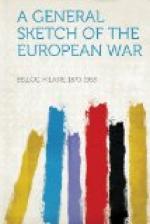TANNENBERG.
The province of East Prussia is of a character peculiar in the German Empire and in Europe.
That character must be grasped if the reader is to understand what fortunes attended the war in this region; for it is a district which in its history, in its political value, and in its geographical arrangements has very powerfully affected the whole of the campaign.
Historically this district is the cradle of that mixed race whose strict, narrow, highly defined, but quite uncreative policy has now piqued, now alarmed, civilized Europe for almost two hundred years.
[Illustration: Sketch 72.]
The Prussian, or rather the Prussian aristocracy, which, by achieving the leadership of Germany, has flung so heavy a mass at Europe, originated in the rough admixture of certain West German and Christian knights with the vague pagan population of the Eastern Baltic plain, which, until almost the close of the Middle Ages, was still a field for missionary effort and for crusade. It was the business of the Teutonic knights to tame this march of Christendom. They accomplished their work almost out of sight of the governing empire, the Papacy, and Christendom in general, with what infamies history records. The district thus occupied was not within the belt of that high Polish culture which is one of the glories of Europe. Nations may not inexactly be divided into those who seek and those who avoid the sea. The Poles are of the latter type. This belt, therefore, of Borussia (whence our word Prussia is derived)—roughly from the Vistula up on to the Bight of Libau—was held by the Teutonic knights in a sort of savage independence. The Christian faith, which it had been their pretext and at first their motive to spread, took little root;




